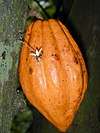Candy making
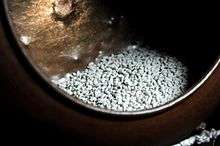
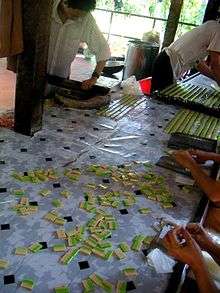
Candy making is the preparation of candies and sugar confections. Candy making includes the preparation of many various candies, such as hard candies, jelly beans, gumdrops, taffy, liquorice, cotton candy, chocolates and chocolate truffles, dragées, fudge, caramel candy and toffee.
Candy is made by dissolving sugar in water or milk to form a syrup, which is boiled until it reaches the desired concentration or starts to caramelize. The type of candy depends on the ingredients and how long the mixture is boiled. Candy comes in a wide variety of textures, from soft and chewy to hard and brittle. A chocolatier is a person who prepares confectionery from chocolate, and is distinct from a chocolate maker, who creates chocolate from cacao beans and other ingredients. Cotton candy is a form of spun sugar often prepared using a cotton candy machine.
History
The technology for candy making has generally kept pace with the technology of the times. For example, when steam power became common in factories, steam power was also used in candy factories.
Candy making and consumption increased greatly during the Industrial Revolution in the 19th century. Candy had previously been made by hand, either occasionally at home or by specialists in small, local businesses. Increased mechanization caused prices to drop and production to increase.
Hard candy

Hard candy, also referred to as boiled sweet, is a candy prepared from one or more syrups boiled to a temperature of 160 °C (320 °F). After a syrup boiled to this temperature cools, it is called hard candy, since it becomes stiff and brittle as it approaches room temperature. Hard candy recipes variously call for syrups of sucrose, glucose, or fructose. To add color, food coloring is sometimes used.[1]
Sugar stages
The final texture of candy depends on the sugar concentration. As the syrup is heated, it boils and the sugar concentration increases as water evaporates. A given temperature corresponds to a particular sugar concentration because the boiling-point elevation of the sugar solution is a colligative property (i.e., it is related to the concentration of the solution), so temperature is used as a marker for the necessary concentration.[2] In general, higher temperatures and greater sugar concentrations result in hard, brittle candies, and lower temperatures result in softer candies. The stages of sugar cooking are as follows:[3]
| Stage | Temperature | Sugar concentration |
|---|---|---|
| thread (e.g., syrup) | 110 to 112 °C (230 to 234 °F) | 80% |
| soft ball (e.g., fudge) | 112 to 116 °C (234 to 241 °F) | 85% |
| firm ball (e.g., soft caramel candy) | 118 to 120 °C (244 to 248 °F) | 87% |
| hard ball (e.g., nougat) | 121 to 130 °C (250 to 266 °F) | 90% |
| soft crack (e.g., salt water taffy) | 132 to 143 °C (270 to 289 °F) | 95% |
| hard crack (e.g., toffee) | 146 to 154 °C (295 to 309 °F) | 99% |
| clear liquid | 160 °C (320 °F) | 100% |
| brown liquid (e.g., liquid caramel) | 170 °C (338 °F) | 100% |
| burnt sugar | 177 °C (351 °F) | 100% |
The names come from the methods used to test the syrup before thermometers became affordable. The "thread" stage is tested by cooling a little syrup, and pulling it between the thumb and forefinger. When the correct stage is reached, a thread will form. This stage is used for making syrups. For subsequent stages, a small spoonful of syrup is dropped into cold water, and the characteristics of the resulting lump are evaluated to determine the concentration of the syrup. A smooth lump indicates "ball" stages, with the corresponding hardness described. At the "soft crack" stage, the syrup forms threads that are just pliable. At the "hard crack" stage, the threads are brittle.[4]
This method is still used today in some kitchens. A candy thermometer is more convenient, but has the drawback of not automatically adjusting for local conditions such as altitude, as the cold water test does.
Once the syrup reaches 171 °C (340 °F) or higher, the sucrose molecules break down into many simpler sugars, creating an amber-colored substance known as caramel. This should not be confused with caramel candy, although it is the candy's main flavoring.
Soft candy
Cotton candy
Cotton candy, also known as Candy Floss, is a form of spun sugar.[5] Typical machines used to make cotton candy include a spinning head enclosing a small bowl into which granulated sugar is poured.[5] Colored sugar[6] or separate sugar and food coloring are used to provide color. Heaters near the rim of the head melt the sugar, which is squeezed out through tiny holes by centrifugal force, and the molten sugar solidifies in the air and is caught in a larger bowl which totally surrounds the spinning head.[6] After the product builds up on the inside walls of the larger bowl, a stick, cone, or hands are inserted, upon which the sugar strands are gathered.
- The bowl of a cotton candy machine
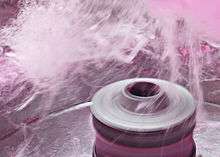 The spinning head of a cotton candy machine
The spinning head of a cotton candy machine- Cotton candy being prepared
Marshmallows
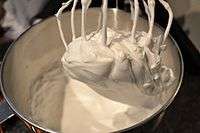
Marshmallows are prepared using egg whites, corn syrup and sugar. The use of marshmallow to make a sweet dates back to ancient Egypt, where the recipe called for an extract from the root of the marshmallow plant (Althaea officinalis) and mixing it with nuts and honey. Another pre-modern recipe uses the pith of the marshmallow plant, rather than the root. In modern times, marshmallows are often commercially prepared using extrusion.
Chocolatiering
Chocolatiering, the preparing of confections from chocolate, involves the techniques of tempering, molding and sculpting. Tempering is a heat treatment method performed on chocolate involving heating and cooling the chocolate to result in desired characteristics like shininess of the chocolate or 'snap', the way it breaks.[7] Molding is a design technique used in making chocolate pieces that are of a certain shape by taking liquid chocolate and pouring it into a mold and letting it harden.[8] Sculpting is a type of three-dimensional artwork that may involve using molds and pieces of chocolate, and decorating the piece with designs in chocolate.
- A chocolatier making chocolate eggs
- A chocolatier making a chocolate tower
Tools and machinery
A variety of tools and machines are used in making candy, ranging from simple kitchen tools like bowls and spoons to elaborate factory machinery.
Because exact temperature control is critical for some candies, a common tool is the candy thermometer. Inexpensive candy thermometers measure food temperatures up to about 160 °C, and those designed for commercial candy production may run even higher.[2]
A starch mogul is used in candy factories to shape soft candies or candy centers from syrups or gels. These centers may then be sent through a chocolate enrober to coat them in chocolate.
See also
References
- ↑ Candy Making Made Easy - Tamara E. Serna. p. 34.
- 1 2 Brown, Amy (2014). Understanding Food: Principles and Preparation. Cengage Learning. pp. 520–521. ISBN 9781285954493.
- ↑ The Cold Water Candy Test, Exploratorium; Sugar Syrup Chart at Baking911
- ↑ Sugar Work at Cooking4Chumps
- 1 2 Water Properties in Food, Health, Pharmaceutical and Biological Systems .... p. 95.
- 1 2 The Rotarian. p. 35.
- ↑ Chu, Michael (2006-11-12). "Tempering Chocolate - Kitchen Notes". Cooking For Engineers. Retrieved 2012-01-27.
- ↑ "Mold - Definition and More from the Free Merriam-Webster Dictionary". Merriam-webster.com. Retrieved 2012-01-27.
Further reading
External links


